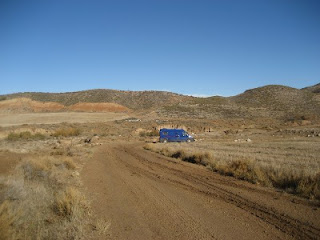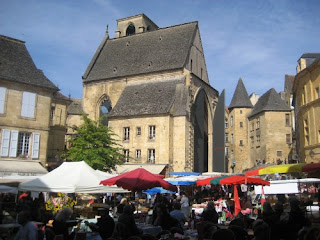
We were keen to get into a proper site where we could celebrate the festive season with unlimited showers, mains electricity, hanging our washing out to dry and not being moved on by the police, having a drink at lunchtime and not having to drive in the afternoon. We only called into Calpe to reconnoitre for a later visit when the Swansea Dunstones come south in January, but the campsite was much nicer than the one we'd planned ... so here we are.
We're surrounded by lovely German, Dutch and a few British people. We were hoping to have an opportunity to improve our Spanish during this trip, but so far this Christmas it's our rusty 'O' level German that's been exercised. Most of the others are here for weeks or even months, settled in big caravans with big awnings with the full paraphernalia of fairy lights, Christmas trees and a full set of electric kitchen appliances. On our first morning our neighbours took charge and badgered us into moving our van to a sunnier pitch. We moved with some grumbling, but the result was that we spent Christmas morning eating pancakes outside while Scooby (AKA 'Liebe Hündchen') basked in the sunshine.
Big parts of the town have a very German flavour. There's a bar by the supermarket called 'Ambiente Aleman' where Germans sit at the bar drinking lager and eating sausage with sauerkraut and dumplings, and the local baker has a pretzel logo. We'd be much less tolerant of their British equivalents, but Germans do Gemütlich so well that so far it just makes us want to visit Germany in the summer.
At mid-day on Christmas day we were disturbed from sunning ourselves by a car moving slowly through the site tooting its horn, then delighted to find it was the family who own the site distributing a bottle of cava and a rose in a gift bag to each pitch. Finally we got to say '¡Feliz Navidad!' to someone!
Our neighbours are so delighted with the warm weather and the sunshine, it's impossible to continue to fool ourselves into believing that December in northern Europe is anything other than miserable. Will we ever be able to put up with it again? Will you be able to put up with it again after reading this? Will you be able to put up with us when we get back?
On Christmas Eve we watched some Spanish TV – very different from what we'd expect in Britain. One item was a long 'round up' of what the Spanish royal family have been up to this year followed by the King's annual speech. He spent most of his speech discussing the economic crisis, saying how important it was that all Spaniards should unite to overcome it. He also had a photo in the background of the Spanish World Cup team and said how proud everyone was of their achievement.
However, the following programme, which was extremely entertaining, had features on how various groups of people were celebrating Christmas in different parts of Spain. This programme highlighted the diversity of Spain – and made us wonder if the King had any chance of uniting the country, if he even really has a single country to unite. The programme featured rough female cockle pickers in Galicia, doing a hard, cold job in icy December waters, dressed up for Christmas and very respectable but obviously very poor; wild gypsy-like people from Jerez who sang and danced lustily in a very un-european way – even a granny of about 70 was flashing her legs and giving a full flamenco performance on camera; a very camp drag queen from Seville who was having a ball with some very odd friends in his apartment; and a group of incredibly elegant and sophisticated Porsche-driving 'beautiful people' from Majorca who were so rich and stylish that it hurt. What do they have in common apart from having the same King on their stamps?
On the way down here in the run-up to Christmas we passed through Catalonia. We're planning to go back later but didn't dare stay for Christmas because they're too odd. A typical trip to Barcelona doesn't give anything like the full impression. Too odd. We thought we'd best leave them to themselves.
Last year on British TV the Jonathan Ross show was very excited to find out about the Catalan tradition of the 'caganer'; the figure in the traditional nativity scene who squats in a quiet corner, defecating. Ross had models specially made of himself and his guests, but the shops in Llieda routinely sell models of defecating politicians, royalty, footballers, Simpsons characters and the Statue of Liberty.
In the run up to Christmas the shops and market stalls all over Catalonia are full of Caga Tiós. They're unusual, but a bit cute; something between a log and a dog.
Stella loved them and we thought we might buy a small one if we weren't so short of space. However, with a bit of Googling we find they are the traditional shitting/ giving log that Catalan children beat with sticks, while singing traditional songs, so that they defecate dried fruit and sweets for them.
During a brief visit to Valls, in the Catalan heartland north of Tarragona, we came across another Catalan tradition that even the BBC didn't uncover. On the sweet stall in the market were 'Primaveras', which looked like this:
During our first brief visit to Catalonia in the autumn they were preparing for their general election for the Catalan parliament. One of the candidates, an advocate of independence, used the slogan 'To be Catalan is to work hard and think clearly'.
He forgot to say 'and to be preoccupied with faeces'. Or is it that the Catalans are normal and everyone else is odd?
¡Bones festes! (that's Valencian, by the way) one and all.























